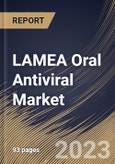The market is predicted to increase quickly due to the therapeutic landscape's shift toward biologics and increasing understanding of molecular mechanisms. Furthermore, the newly produced product is being given special drug designation by the regulatory authorities, which benefits the vendors and helps to increase sales of oral antiviral medications, which will help the market grow in the upcoming years.
Time is needed, and market income and profit are constrained as a safe, effective, and tailored antiviral is developed from the ground up. In addition, potential viral pandemics highlight the requirement for broad-spectrum antiviral drugs, such as direct-acting antivirals, that can be quickly and broadly applied to stop viral spread until suitable vaccinations are created. The market is also anticipated to be constrained by a growing understanding of vaccination accessibility and infection prevention techniques.
The Saudi Arabian government's Vision 2030 plans to spend $65 billion to build the nation's healthcare system. Additionally, by 2030, it plans to increase the private sector's participation from 405 to 65%. Furthermore, they want to privatize 2,300 major health facilities, including 290 hospitals. The Ministry of Healthcare also intends to establish a health cluster throughout Saudi Arabia to advance integrated and preventative care and improve access to healthcare services. Growing healthcare spending and infrastructure will encourage regional market expansion by encouraging market participants to invest in and diversify their regional activities.
The Brazil market dominated the LAMEA Oral Antiviral Market by Country in 2022 thereby, achieving a market value of $700.2 million by 2029. The Argentina market is experiencing a CAGR of 6% during (2023-2029). Additionally, The UAE market would exhibit a CAGR of 5.1% during (2023-2029).
Based on Indication, the market is segmented into Human Immunodeficiency Virus (HIV), Hepatitis, Influenza and Others. Based on Drug Class, the market is segmented into Reverse Transcriptase Inhibitors, Protease Inhibitors and Others. Based on Distribution Channel, the market is segmented into Drug Store & Retail Pharmacies, Hospital Pharmacies and Online Providers. Based on countries, the market is segmented into Brazil, Argentina, UAE, Saudi Arabia, South Africa, Nigeria, and Rest of LAMEA.
The market research report covers the analysis of key stake holders of the market. Key companies profiled in the report include Johnson & Johnson, F. Hoffmann-La Roche Ltd., Merck & Co., Inc., Bristol Myers Squibb Company, Gilead Sciences, Inc., Viatris, Inc. (Mylan N.V.), AbbVie, Inc., GlaxoSmithKline PLC (GSK), Teva Pharmaceutical Industries Ltd., and Amneal Pharmaceuticals, Inc.
Scope of the Study
By Indication
- Human Immunodeficiency Virus (HIV)
- Hepatitis
- Influenza
- Others
By Drug Class
- Reverse Transcriptase Inhibitors
- Protease Inhibitors
- Others
By Distribution Channel
- Drug Store & Retail Pharmacies
- Hospital Pharmacies
- Online Providers
By Country
- Brazil
- Argentina
- UAE
- Saudi Arabia
- South Africa
- Nigeria
- Rest of LAMEA
Key Market Players
List of Companies Profiled in the Report:
- Johnson & Johnson
- F. Hoffmann-La Roche Ltd.
- Merck & Co., Inc.
- Bristol Myers Squibb Company
- Gilead Sciences, Inc.
- Viatris, Inc. (Mylan N.V.)
- AbbVie, Inc.
- GlaxoSmithKline PLC (GSK)
- Teva Pharmaceutical Industries Ltd.
- Amneal Pharmaceuticals, Inc.
Unique Offerings
- Exhaustive coverage
- The highest number of Market tables and figures
- Subscription-based model available
- Guaranteed best price
- Assured post sales research support with 10% customization free
Table of Contents
Companies Mentioned
- Johnson & Johnson
- F. Hoffmann-La Roche Ltd.
- Merck & Co., Inc.
- Bristol Myers Squibb Company
- Gilead Sciences, Inc.
- Viatris, Inc. (Mylan N.V.)
- AbbVie, Inc.
- GlaxoSmithKline PLC (GSK)
- Teva Pharmaceutical Industries Ltd.
- Amneal Pharmaceuticals, Inc.








